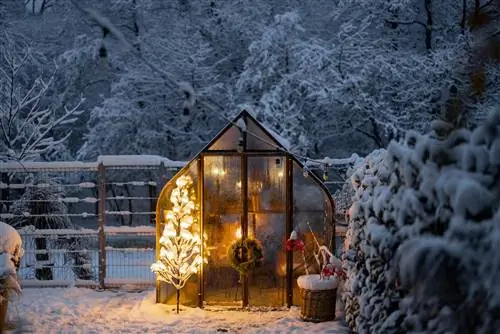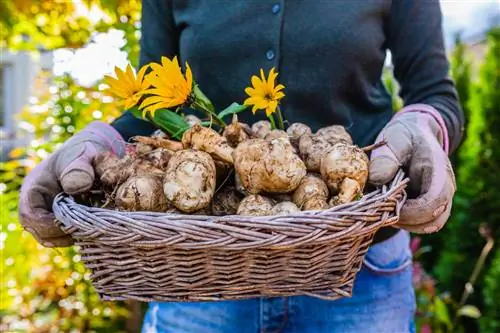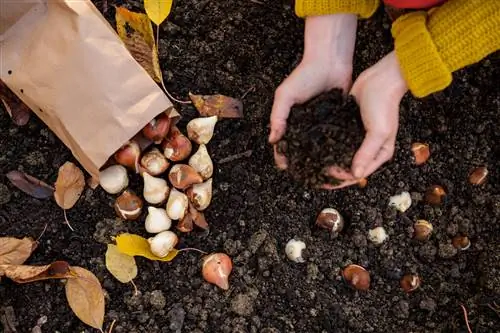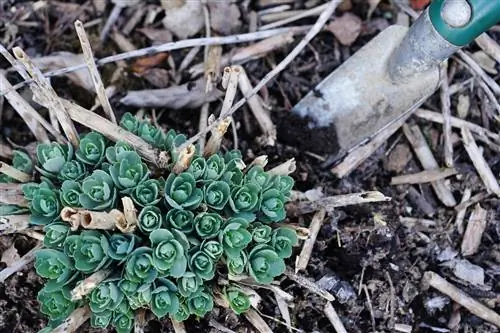- Author admin [email protected].
- Public 2024-01-15 08:07.
- Last modified 2025-06-01 06:02.
The first preparations for the new gardening season can be made in January. Whether buying seeds or cleaning tools - the work is worth it. If you use a greenhouse as winter quarters for cold-sensitive plants, protect it with a frost monitor in cold temperatures. The new gardening year can start with sowing radishes or spinach.

What are the most important gardening tasks in January?
In January, cold germination plants should be sown outdoors and sensitive plants should be placed on the windowsill. Harvesting winter vegetables such as Brussels sprouts, kale and lamb's lettuce. Cutting fruit trees and shrubs (except early bloomers). Grow herbs and microgreens, prefer tomatoes. Protection against pests and fungal diseases, protect potted plants. Checking supplies, winter cleaning in the tool shed, garden planning.
Summary
Although the garden is now in hibernation, work still awaits the busy gardener. The first seeds can be sown and the first plants can be grown on the windowsill. You also now have time to browse through gardening books and plan the new gardening year.
- Sowing: Cold germinators outdoors, some sensitive vegetable and ornamental plants on the windowsill
- Harvests: Winter vegetables such as Brussels and kale, lamb's lettuce and red chicory salad
- Plants: not possible in January
- Propagate: not possible in January
- Cutting: Fruit trees, shrubs (except trees that bloom in spring such as forsythia etc.
- Other gardening tasks: Growing herbs and microgreens on the windowsill, preferring tomatoes etc., protecting plants from pests and fungal diseases, protecting potted plants, checking supplies, winter cleaning in the tool shed, planning of the coming gardening year
Sowing in January
- Sowing outdoors: Some seeds, especially from domestic plants, only germinate if the germination inhibition has previously been released by a cold stimulus. These also include, for example, Christmas roses, violets, keys to heaven, lady's mantle, monkshood and bleeding heart. Wild garlic and woodruff are also included. If you want to grow these perennials yourself, sow them in trays filled with soil and sift the seeds thinly with sand. Water them vigorously and then lower the containers, covered with fleece, into the ground in a protected garden spot.
- Sowing in the greenhouse: Alternatively, the seed trays mentioned above can also be placed in the unheated greenhouse.
- Sowing on the windowsill: Now is also the right time to prefer heat-loving vegetable plants on the windowsill. Many popular varieties - such as tomatoes, physalis, chili, peppers, early kohlrabi, savoy cabbage and cauliflower varieties, beetroot, summer leeks and onions - can be trained now and planted out in spring when temperatures are appropriately warm.
Harvests in January
Since winter vegetables such as Brussels sprouts, kale, lamb's lettuce and red chicory salad can remain outside even in frosty temperatures if covered with pine branches or polytunnels in snowy weather, you can still harvest fresh vegetables and lettuce even in January. As long as the ground is not frozen, Jerusalem artichoke tubers or salsify can still be dug up. Also covered with protective pine branches, fresh, green leaves can also be harvested from parsley, spoonwort and winter purslane.
Plants that bloom in January
Even in the depths of winter and even in frost, there are still some carefree winter bloomers. In the garden, these plants in particular delight us with their splendor of flowers:
- Snowdrops (Galanthus): in mild weather they bloom from January until March
- Christmas rose (Helleborus niger): also known as snow rose, blooms between December and March
- Winter snowball (Viburnum x bodnantense): also Bodnant viburnum, blooms between January and March with white or pink flowers
- Snow heather (Erica carnea): delicate, purple flowers between January and April
- Winter jasmine (Jasminum nudiflorum): beautiful yellow flowers between January and March
- Magic hazel (witch hazel): also yellow flowers from January to the beginning of spring
Popular houseplants such as amaryllis, flaming cat, potted azalea, Christ thorn, indoor cyclamen and the Christmas cactus are now blooming on the warm windowsill.
Planting and propagating in January
Since it is usually frosty and cold in January and snow can cover the garden floor, planting ornamental or useful plants is not advisable. Even in mild weather, you should avoid doing this, as an unexpected onset of winter can occur at any time. In this case, the new plantings would die because they have not yet been able to take root properly. So it's better to postpone this project until a later date. The same applies to propagating plants, as they are now all in hibernation. Only some houseplants that come from the tropics and overwinter warmly can now be propagated by cuttings. However, make sure that they receive enough light - for example from plant lamps - and are cared for as needed.
Cutting in January
In January, most plants are in hibernation. Now is the right time to trim trees and shrubs. But be careful: only use scissors on frost-free days! When there is severe frost, all gardening work comes to a h alt. The weather should also be dry, i.e. H. never cut when it rains - this can introduce unwanted fungal pathogens and cause illness.
- Fruit trees: Older fruit trees can be thinned out in January or rejuvenated if necessary. Larger wounds should be covered with a suitable agent - for example tree wax or (unscented!) candle wax, ground charcoal or clay. This means they are protected from invading pathogens and thus from infections, do not dry out and heal better. In the case of currants and gooseberries, the oldest shoots, recognizable by their dark bark, are cut out low to the ground. This gives the bushes air again and space for new shoots, which then sprout in spring.
- Ornamental shrubs: As long as the temperatures do not drop below minus four degrees Celsius, you can also cut ornamental shrubs in January. Only species that bloom in spring, such as forsythia, will leave you alone. Otherwise, the flowers that have already been planted will fall victim to the pruning shears. You can now cut a few branches to plant in the vase. All ornamental shrubs should only be thinned out and not trimmed back! Cut out old branches low to the ground. Also remove any branches that are growing inward or crossing each other. Do not leave any stubs, but cut directly at the base.
Tip
Only very old bushes are radically cut to size, i.e. H. capped just above the ground. This gives you the chance to sprout new growth and rejuvenate yourself. However, in such a case you will have to avoid flowering for at least a year.
Plant diseases and pests in January
Even in winter, it is important not to lose sight of protecting plants from pathogens and pests. The following tasks await you in January.
Frost tensioner:
Check the glue rings on the fruit trees. Frost moths still crawl up the trunks in January, using dry leaves stuck to the glue as a bridge.
Voles:
Have you often had problems with voles? Then you shouldn't make the animals too comfortable! In winter, for example, only lay thin blankets of mulch under the fruit trees, otherwise the soil underneath will be nice and warm for the animals. Also check the tree discs regularly for aisles and their entrances. If you find some, pour in sour buttermilk. The animals don't like the smell and then run away. Garlic and dog or human hair are also said to help.
Hares and wild rabbits:
Hares, wild rabbits and deer suffer from hunger, especially when there is a thick blanket of snow, and therefore come to the gardens more often. Here the animals like to nibble on the bark of various trees, which are damaged as a result. Protect the trunks of trees and bushes with wire mesh pants and distract hungry wildlife with fresh tree cuttings for food.
Fungal diseases:
Sick parts of plants - such as fruit mummies, spotty leaves and twigs - often represent sources of infection for fungal diseases, as the fungal spores overwinter in them. In spring the pathogens infect the plants again. To prevent this, you should remove any leftover residue in January.
More gardening work in January
- Protect potted plants: Even overwintering balcony and potted plants should not be left without care in winter. If the weather is mild, open a window and let fresh air in. Drought and rotting leaves or twigs must be removed promptly to avoid possible infection with pathogens. Just water carefully at longer intervals: the root ball should not be wet, but should not dry out completely either. Also avoid all extremes: frost is just as harmful as too much heat! In the latter case, the plants develop weak, dry shoots much too early.
- Check supplies: Check stored fruit and vegetables in the storage cellar regularly. Sort out fruits with spots, rotten or bruises in good time so that they do not infect the he althy stored goods. It should also be ventilated on frost-free and dry days.
- Winter cleaning in the tool shed: If you haven't done it yet, you should thoroughly clean garden tools such as cultivators, rakes, spades and sow teeth in January. Then oil all metal parts to prevent rusting. Also take a close look at the water sprinkler - if available - or other irrigation systems as well as hoses, polytunnels, tomato stakes, seed containers and other things. Clean everything thoroughly and, if necessary, repair any damaged areas.
- Protect fruit trees from frost cracks: Coat the trunks of fruit trees with lime milk or a mixture of lime, clay and horsetail broth to protect the bark from pests and frost cracks. These occur when it freezes in bright sunshine.
- Remove snow loads: A thick blanket of snow, especially when it is wet, can be dangerous for shrubs and trees as branches and twigs break under the load. Therefore, shake the white burden off all trees in good time.
- Planning the new gardening year: In January you have enough time to plan the new gardening year. Browse through gardening books, browse through current catalogs and plant lists from various garden stores in both stationary and online stores. Be inspired by offers and new varieties and plan in advance the creation of the beds and borders, the sowing and any new plantings or redesigns.
FAQ
What garden work will be done in January?
January is above all a time of planning and preparation for the new gardening year. The creation of beds and borders, sowing and any new plantings need to be carefully planned, and you can also think about possible redesigns now. Catalogs, plant lists and good gardening books offer lots of ideas. You can also start planting some plants (e.g. E.g. tomatoes) are preferable on the windowsill.
What can be sown in January?
In January you can sow cold germinators in a tray and, covered with some fleece, plant them in the ground outside in a protected place. The seeds should not be covered with soil, but only with a thin layer of sand. Many popular perennials can be grown yourself in this way. The first vegetable seeds can now be sown in the house and kept warm until planting.
What do you plant in January?
You should not plant garden plants in January, even if the weather is mild. After all, the weather can change at any time and the freshly planted trees etc. can freeze. After all, they have not yet had time to take root in time. This isn't possible that quickly either, because the plants are in hibernation and aren't growing anyway. That's why it's better to wait until spring before planting.
What will be cut in January?
Now is the time to thin out old fruit trees and bushes or, if necessary, carry out rejuvenation pruning. Currants and gooseberries in particular can now be cut by completely removing old, dark shoots and also removing shoots that are too close together. This gives the bushes air again and space for new shoots. Ornamental shrubs - with the exception of spring bloomers such as forsythia - are also cut in January.
Which plants can be propagated in January?
In the middle of winter, the garden plants are in hibernation and therefore cannot be propagated. However, when pruning fruit trees, suitable scions can be obtained, which can be stored in the cellar until grafting in spring. It's best to put the scions in damp sand so that they don't dry out. Many tropical (and warm overwintered) houseplants can now also be propagated, e.g. B. through cuttings.






